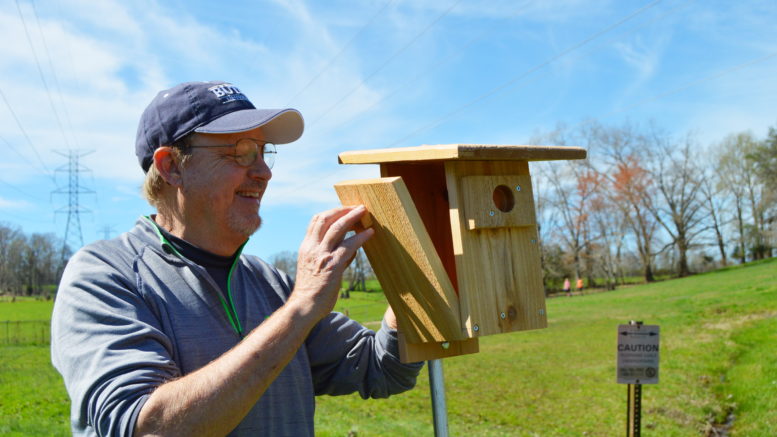Bluebirds finding new homes in Dogwood and Cane Creek parks
COOKEVILLE – Perhaps you’ve noticed them while strolling through Dogwood and Cane Creek parks – small wooden boxes atop metal poles, with a hole in the front.
Just the right size for a bluebird.
The bluebirds sure noticed them, and it didn’t take long for them to inspect the interior, taking bits of grass or pine needles with them.
“Bluebirds are cavity nesters, meaning they always build their nest inside a hole in a tree or a nest box,” said Don Hazel, Tennessee Bluebird Society president, who placed nine boxes in Cookeville’s parks – four at Dogwood and five at Cane Creek. The boxes were built by the Cumberland County Bluebird Club, of which he is a member.
Hazel said bluebirds have fierce competition for nesting sites from non-native species like house sparrows and starlings. So they need help from people.
“These aggressive birds take over available nesting cavities and even kill bluebirds to get a nest site,” he said. “Humans caused the problem by importing non-native birds, and humans can help bluebirds by placing nest boxes to give them a place to live.”
Members of a local garden club were interested in learning more and invited Hazel to present a program about bluebirds during their March meeting. They then formed their own bluebird club and contacted Cookeville Leisure Services about placing boxes in city parks.
They are monitoring the new nesting boxes weekly by opening them from the side and noting the species of bird, stage of nesting, number of eggs, number and age of baby birds and number of birds that fledge successfully from the nest.
“If necessary, the monitors remove wasp nests, treat for insects, remove non-native house sparrow nests and check for problems,” Hazel said. “The bluebird society has found there is a higher success rate on boxes that are monitored versus boxes that are not.”
North American Bluebird Society-approved boxes are ideal for bluebirds. The 1 ½-inch hole keeps starlings out, and the lack of a perch discourages sparrows. Other features include a double-thick entrance hole to prevent raccoons from reaching inside, inside screen so the baby birds can climb out, roof overhang for protection from sun and rain and, most importantly, a way to open the nest box to check on problems and to clean out old nests once the baby birds fledge.
As for location, bluebirds prefer open grassy areas where they can feed on insects. Boxes should be placed at least 100 yards apart, as bluebirds are territorial. They will lay four to six blue eggs and raise two to three broods per year, building a new nest each time.
Hazel said that while bluebirds are tolerant of humans, park visitors should avoid disturbing the boxes.
“We’d like people to just enjoy watching the bluebirds coming and going,” he said.
It’s something Hazel enjoys doing.
“Bluebirds are easy to like,” he said. “And the thing is, they need our help.”
Photo cutline:
Don Hazel, Tennessee Bluebird Society president and Cumberland County Bluebird Club member, places a bluebird nesting box at Cane Creek Park.

